Page 286 of 496
STARTING AND OPERATING
CONTENTS
�Starting Procedures .................... 290
▫ Manual Transmission – If Equipped ....... 290
▫ Automatic Transmission – If Equipped ..... 290
▫ Normal Starting ..................... 291
▫ Extreme Cold Weather
(Below �20°F Or �29°C)............... 291
▫ If Engine Fails To Start ................ 292
▫ After Starting ....................... 292
� Engine Block Heater — If Equipped ........ 292�
Manual Transmission — If Equipped ........ 293
▫ Five–Speed Manual Transmission ......... 293
▫ Recommended Shift Speeds ............. 294
▫ Downshifting ....................... 294
� Automatic Transmission — If Equipped ...... 295
▫ Brake/Transmission Interlock System ...... 296
▫ Automatic Transmission Ignition Interlock
System ............................ 296
▫ Gear Ranges ........................ 297
5
Page 291 of 496
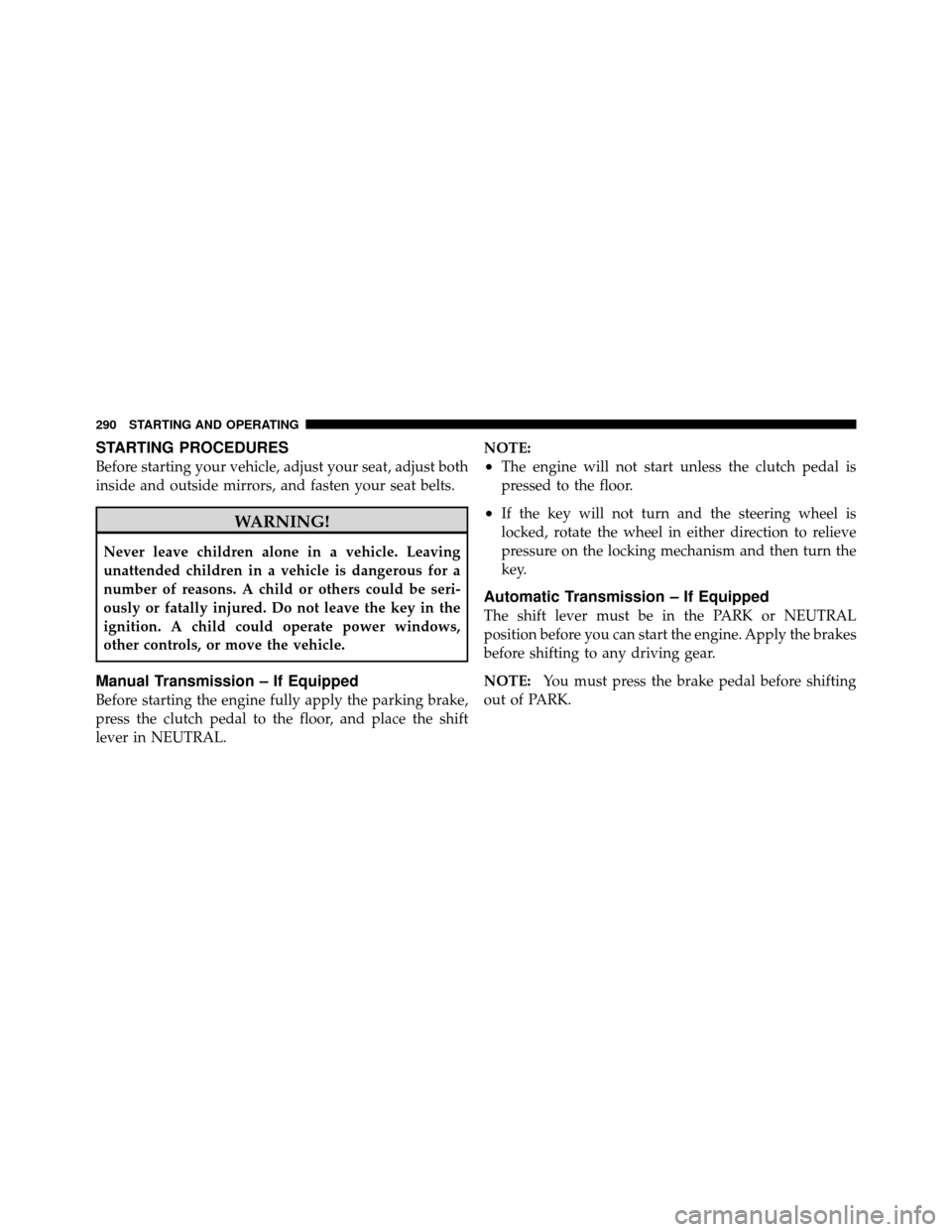
STARTING PROCEDURES
Before starting your vehicle, adjust your seat, adjust both
inside and outside mirrors, and fasten your seat belts.
WARNING!
Never leave children alone in a vehicle. Leaving
unattended children in a vehicle is dangerous for a
number of reasons. A child or others could be seri-
ously or fatally injured. Do not leave the key in the
ignition. A child could operate power windows,
other controls, or move the vehicle.
Manual Transmission – If Equipped
Before starting the engine fully apply the parking brake,
press the clutch pedal to the floor, and place the shift
lever in NEUTRAL.NOTE:
•The engine will not start unless the clutch pedal is
pressed to the floor.
•If the key will not turn and the steering wheel is
locked, rotate the wheel in either direction to relieve
pressure on the locking mechanism and then turn the
key.
Automatic Transmission – If Equipped
The shift lever must be in the PARK or NEUTRAL
position before you can start the engine. Apply the brakes
before shifting to any driving gear.
NOTE:
You must press the brake pedal before shifting
out of PARK.
290 STARTING AND OPERATING
Page 296 of 496
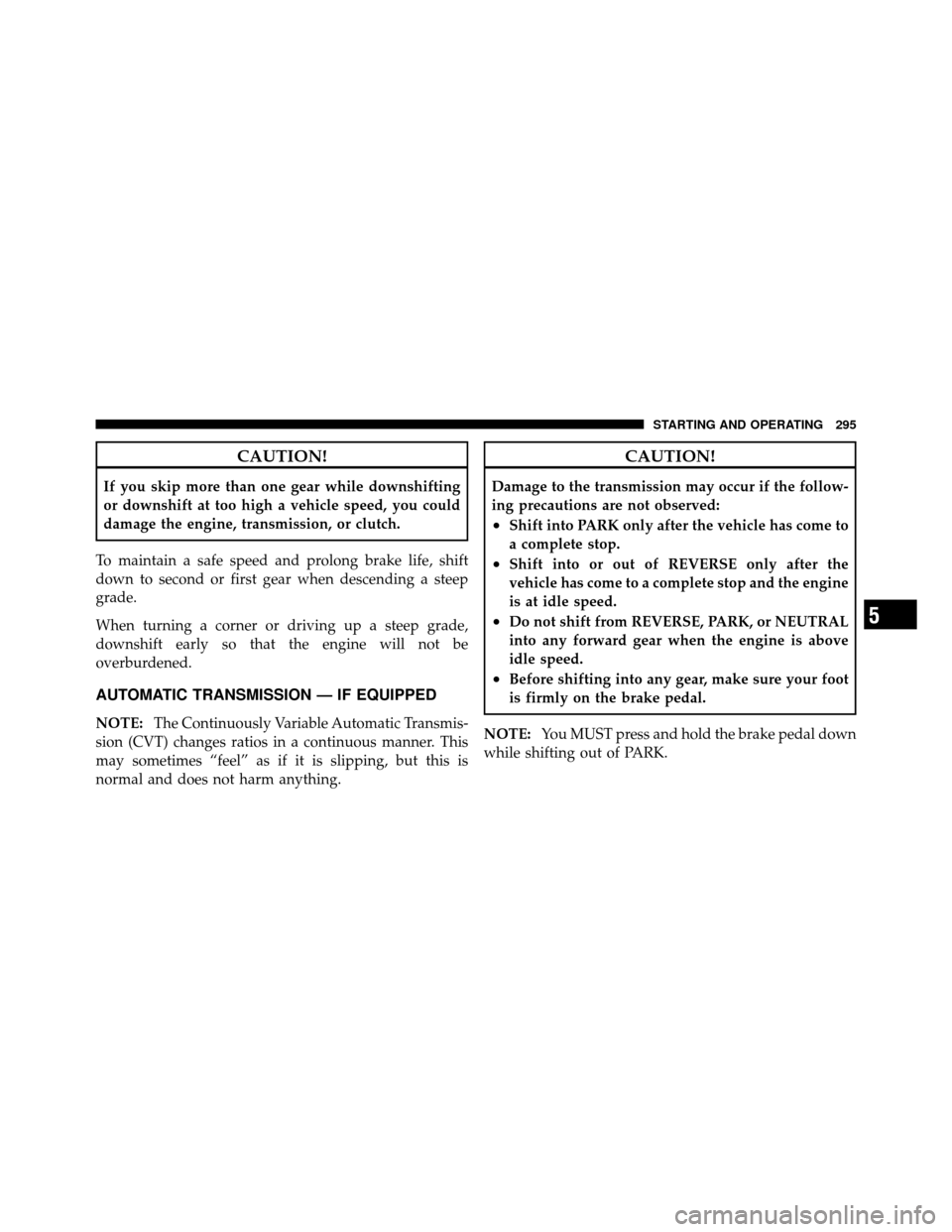
CAUTION!
If you skip more than one gear while downshifting
or downshift at too high a vehicle speed, you could
damage the engine, transmission, or clutch.
To maintain a safe speed and prolong brake life, shift
down to second or first gear when descending a steep
grade.
When turning a corner or driving up a steep grade,
downshift early so that the engine will not be
overburdened.
AUTOMATIC TRANSMISSION — IF EQUIPPED
NOTE: The Continuously Variable Automatic Transmis-
sion (CVT) changes ratios in a continuous manner. This
may sometimes “feel” as if it is slipping, but this is
normal and does not harm anything.
CAUTION!
Damage to the transmission may occur if the follow-
ing precautions are not observed:
•Shift into PARK only after the vehicle has come to
a complete stop.
•Shift into or out of REVERSE only after the
vehicle has come to a complete stop and the engine
is at idle speed.
•Do not shift from REVERSE, PARK, or NEUTRAL
into any forward gear when the engine is above
idle speed.
•Before shifting into any gear, make sure your foot
is firmly on the brake pedal.
NOTE: You MUST press and hold the brake pedal down
while shifting out of PARK.
5
STARTING AND OPERATING 295
Page 297 of 496
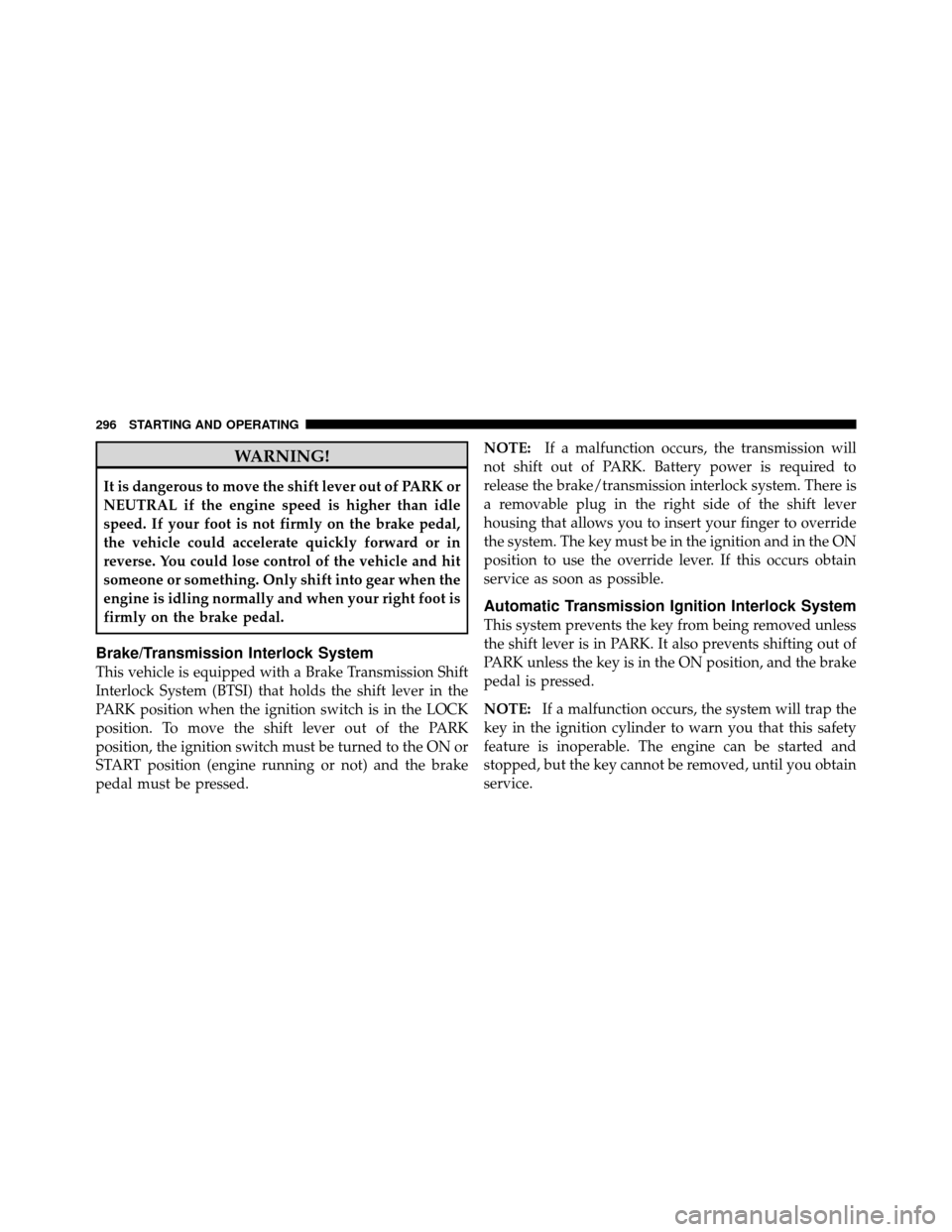
WARNING!
It is dangerous to move the shift lever out of PARK or
NEUTRAL if the engine speed is higher than idle
speed. If your foot is not firmly on the brake pedal,
the vehicle could accelerate quickly forward or in
reverse. You could lose control of the vehicle and hit
someone or something. Only shift into gear when the
engine is idling normally and when your right foot is
firmly on the brake pedal.
Brake/Transmission Interlock System
This vehicle is equipped with a Brake Transmission Shift
Interlock System (BTSI) that holds the shift lever in the
PARK position when the ignition switch is in the LOCK
position. To move the shift lever out of the PARK
position, the ignition switch must be turned to the ON or
START position (engine running or not) and the brake
pedal must be pressed.NOTE:
If a malfunction occurs, the transmission will
not shift out of PARK. Battery power is required to
release the brake/transmission interlock system. There is
a removable plug in the right side of the shift lever
housing that allows you to insert your finger to override
the system. The key must be in the ignition and in the ON
position to use the override lever. If this occurs obtain
service as soon as possible.
Automatic Transmission Ignition Interlock System
This system prevents the key from being removed unless
the shift lever is in PARK. It also prevents shifting out of
PARK unless the key is in the ON position, and the brake
pedal is pressed.
NOTE: If a malfunction occurs, the system will trap the
key in the ignition cylinder to warn you that this safety
feature is inoperable. The engine can be started and
stopped, but the key cannot be removed, until you obtain
service.
296 STARTING AND OPERATING
Page 300 of 496
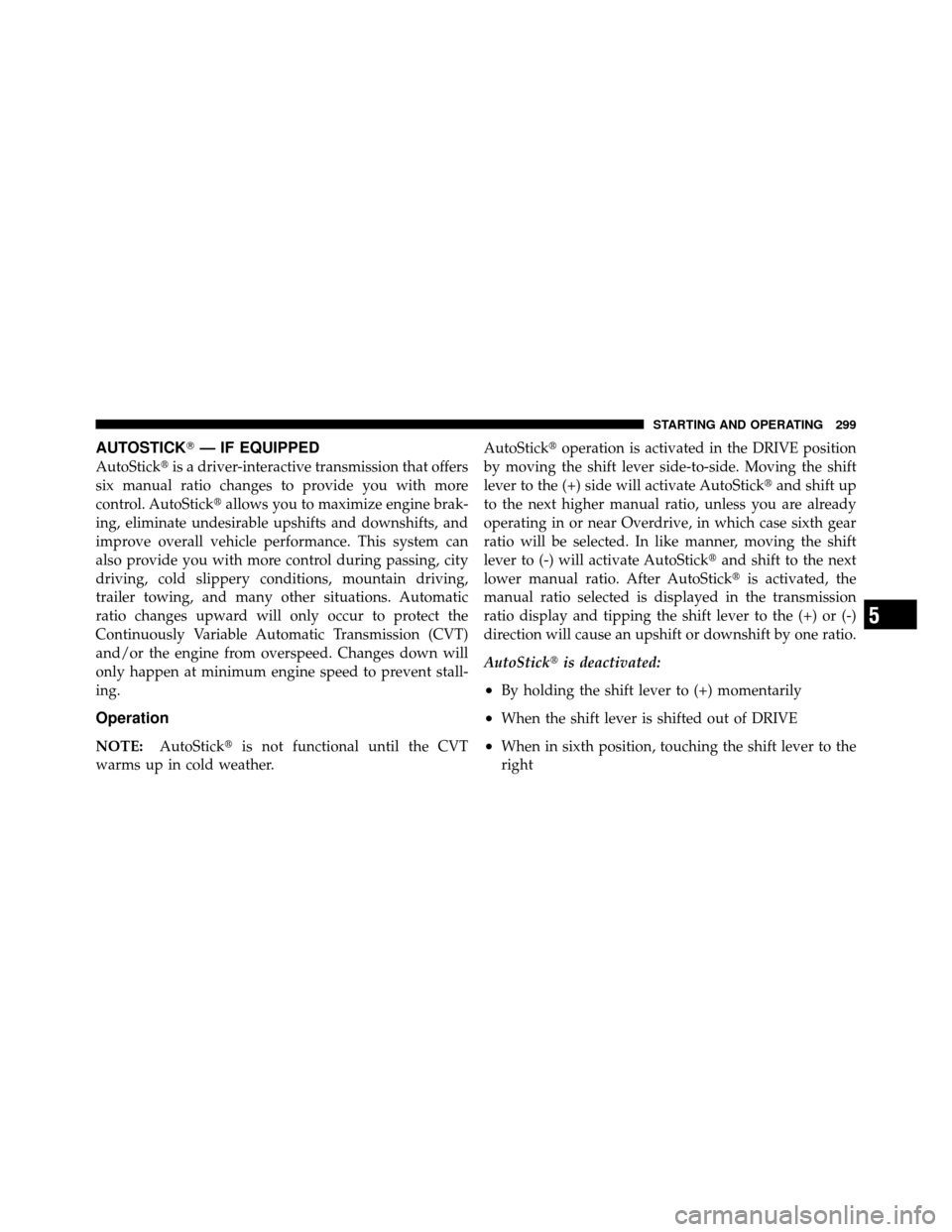
AUTOSTICK�— IF EQUIPPED
AutoStick�is a driver-interactive transmission that offers
six manual ratio changes to provide you with more
control. AutoStick� allows you to maximize engine brak-
ing, eliminate undesirable upshifts and downshifts, and
improve overall vehicle performance. This system can
also provide you with more control during passing, city
driving, cold slippery conditions, mountain driving,
trailer towing, and many other situations. Automatic
ratio changes upward will only occur to protect the
Continuously Variable Automatic Transmission (CVT)
and/or the engine from overspeed. Changes down will
only happen at minimum engine speed to prevent stall-
ing.
Operation
NOTE: AutoStick� is not functional until the CVT
warms up in cold weather. AutoStick�
operation is activated in the DRIVE position
by moving the shift lever side-to-side. Moving the shift
lever to the (+) side will activate AutoStick� and shift up
to the next higher manual ratio, unless you are already
operating in or near Overdrive, in which case sixth gear
ratio will be selected. In like manner, moving the shift
lever to (-) will activate AutoStick� and shift to the next
lower manual ratio. After AutoStick� is activated, the
manual ratio selected is displayed in the transmission
ratio display and tipping the shift lever to the (+) or (-)
direction will cause an upshift or downshift by one ratio.
AutoStick� is deactivated:
•By holding the shift lever to (+) momentarily
•When the shift lever is shifted out of DRIVE
•When in sixth position, touching the shift lever to the
right
5
STARTING AND OPERATING 299
Page 301 of 496
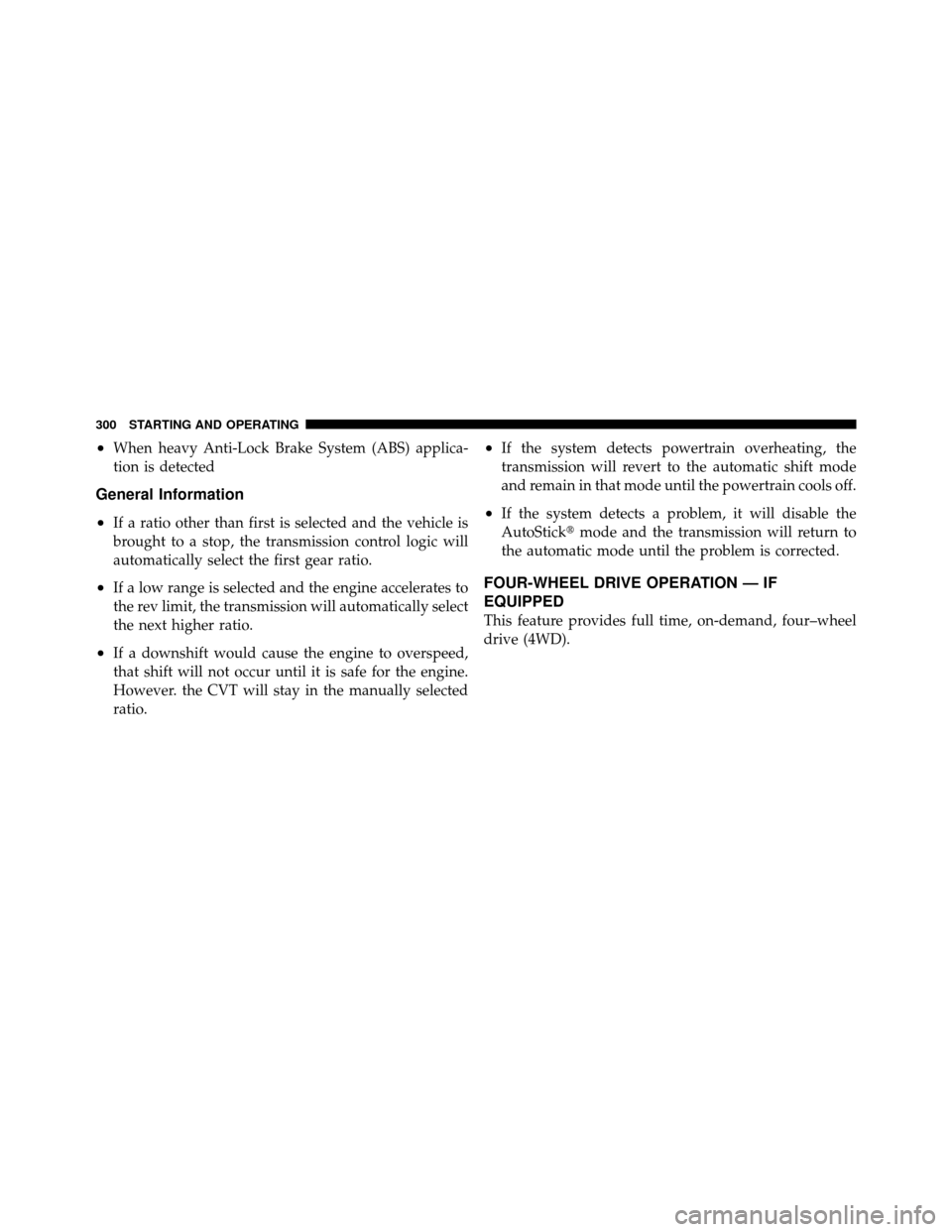
•When heavy Anti-Lock Brake System (ABS) applica-
tion is detected
General Information
•
If a ratio other than first is selected and the vehicle is
brought to a stop, the transmission control logic will
automatically select the first gear ratio.
•If a low range is selected and the engine accelerates to
the rev limit, the transmission will automatically select
the next higher ratio.
•If a downshift would cause the engine to overspeed,
that shift will not occur until it is safe for the engine.
However. the CVT will stay in the manually selected
ratio.
•If the system detects powertrain overheating, the
transmission will revert to the automatic shift mode
and remain in that mode until the powertrain cools off.
•If the system detects a problem, it will disable the
AutoStick�mode and the transmission will return to
the automatic mode until the problem is corrected.
FOUR-WHEEL DRIVE OPERATION — IF
EQUIPPED
This feature provides full time, on-demand, four–wheel
drive (4WD).
300 STARTING AND OPERATING
Page 317 of 496
If necessary, add fluid to restore to the proper indicated
level. With a clean cloth, wipe any spilled fluid from all
surfaces. Refer to “Fluids, Lubricants, and Genuine
Parts” in “Maintaining Your Vehicle” for further
information.
PARKING BRAKE
Before leaving the vehicle, make sure that the parking
brake is fully applied. Also, be certain to leave an
automatic transmission in PARK, or manual transmission
in REVERSE or first gear.
The parking brake lever is located in the center console.
To apply the parking brake, pull the lever up as firmly as
possible. To release the parking brake, pull the lever up
slightly, press the center button, then lower the lever
completely.When the parking brake is applied with the ignition
switch in the ON position, the “Brake Warning Light” in
the instrument cluster will illuminate.
Parking Brake
316 STARTING AND OPERATING
Page 318 of 496
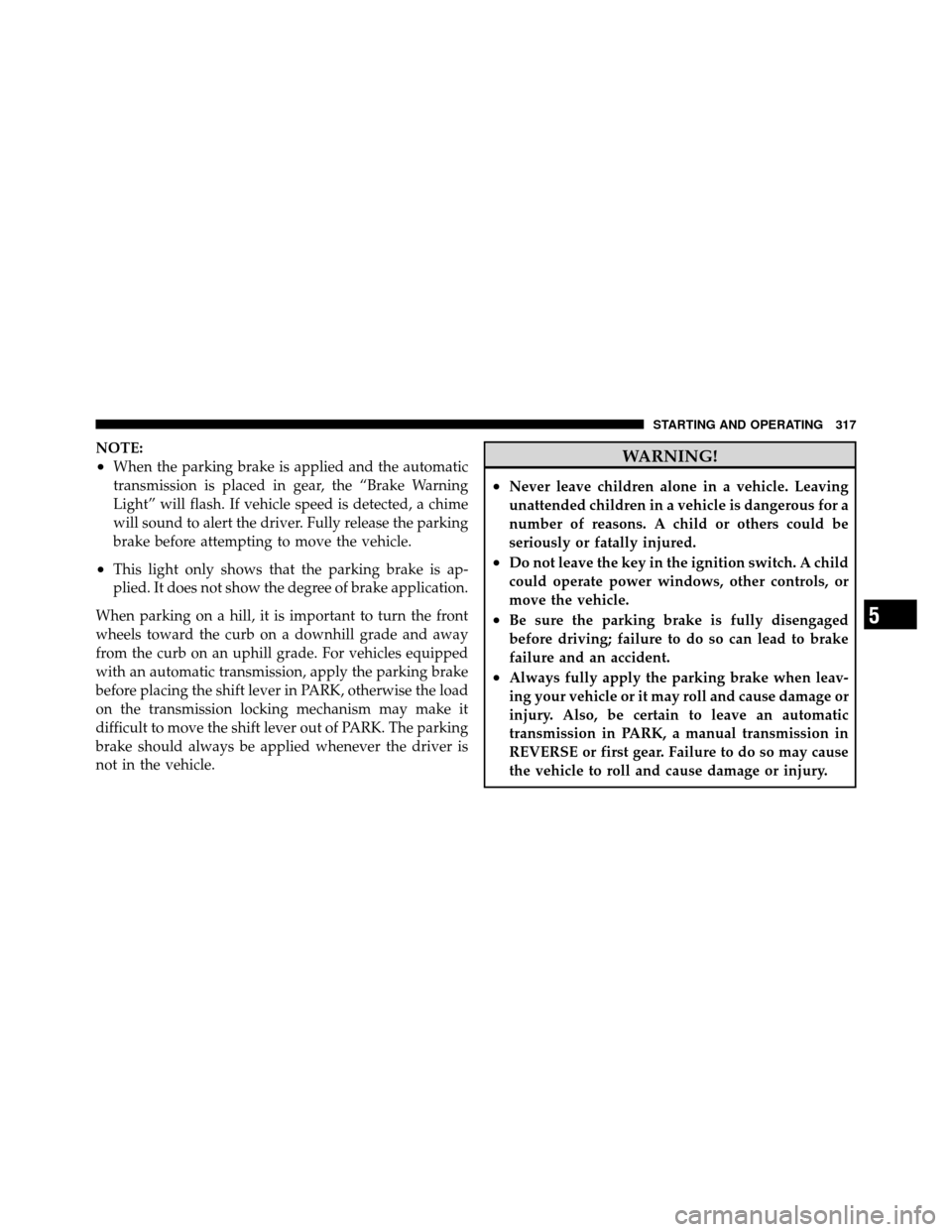
NOTE:
•When the parking brake is applied and the automatic
transmission is placed in gear, the “Brake Warning
Light” will flash. If vehicle speed is detected, a chime
will sound to alert the driver. Fully release the parking
brake before attempting to move the vehicle.
•This light only shows that the parking brake is ap-
plied. It does not show the degree of brake application.
When parking on a hill, it is important to turn the front
wheels toward the curb on a downhill grade and away
from the curb on an uphill grade. For vehicles equipped
with an automatic transmission, apply the parking brake
before placing the shift lever in PARK, otherwise the load
on the transmission locking mechanism may make it
difficult to move the shift lever out of PARK. The parking
brake should always be applied whenever the driver is
not in the vehicle.
WARNING!
•Never leave children alone in a vehicle. Leaving
unattended children in a vehicle is dangerous for a
number of reasons. A child or others could be
seriously or fatally injured.
•Do not leave the key in the ignition switch. A child
could operate power windows, other controls, or
move the vehicle.
•Be sure the parking brake is fully disengaged
before driving; failure to do so can lead to brake
failure and an accident.
•Always fully apply the parking brake when leav-
ing your vehicle or it may roll and cause damage or
injury. Also, be certain to leave an automatic
transmission in PARK, a manual transmission in
REVERSE or first gear. Failure to do so may cause
the vehicle to roll and cause damage or injury.
5
STARTING AND OPERATING 317